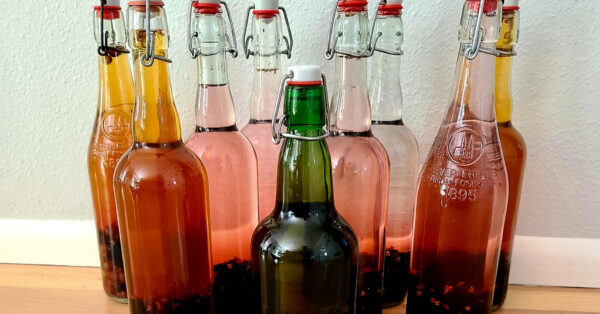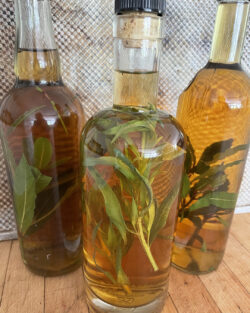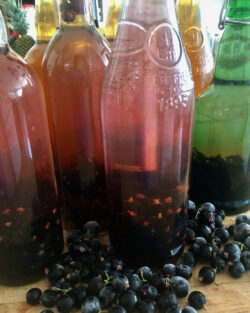Magic Potions: Make Your Own Infused Vinegars

There is a magic ingredient hiding in your kitchen that can boost the flavor of your meals, help keep your house clean, and get rid of nasty weeds in your garden.
What is this magic potion? It’s something so simple—vinegar!
Vinegar is a mild acid (acetic acid, to be precise). The way you buy it at the grocery store, it’s 5% acetic acid—deliciously and perfectly edible. Vinegar can add a sour, tart zing to your foods.
Since sour is one of the five tastes your body is looking for—sweet, salty, bitter, umami, and sour—adding vinegar to your foods will add zip to your meals. Using sour flavors means you will cut way back on the amount of salt you use in foods, which offers a healthy substitution to benefit your blood pressure, heart, and kidneys.

Homemade herb-infused vinegars
Flavored vinegars add an even bigger boost to your meals than plain vinegar since they are both sweet and sour, or sweet, bitter, and sour, depending on the fruit or fresh herbs you use. But most flavored vinegars in stores are much more expensive. So how do we get the flavor without the cost?
Try making your own infused vinegars to save money and give yourself a wonderful flavor palate to work with. You can use white vinegar, apple cider vinegar, wine vinegar, or champagne vinegar. This time of year, rice vinegar with cranberry and citrus is lovely—just make sure you buy the “unseasoned” kind. “Seasoned” rice vinegar has sugar and salt added to it. I’ve even made flavored vinegars out of coconut vinegar, which can be found in Asian specialty shops.
Infused vinegars are simple to make. In fact, they are so simple that you can invite children to help make them. The basic technique is to buy a bottle of vinegar, pour out about one cup of it. You can save it to add back later or use it to clean your windows, floors, bathroom tiles, or pour it on the weeds in your garden. But, back to food … To the bottle, add about a cup of any fresh or frozen berries, any fresh herbs, citrus fruit, citrus peel, kiwi fruit, hot peppers, or ginger. There are so many choices.
Let the herbs and fruit sit in the bottle for about two to three weeks at room temperature. Then strain it, put it in a clean bottle or jug, and then use it in salad dressings, for meat and fish marinades, even mixed with yoghurt or sour cream for a fruit dip.
For fun, use flavored vinegars to add a tart, springy zest to winter salads, or to make great meat marinades. I also like to sprinkle some over oven-roasted vegetables. Try using fruits that are in season now, such as cranberries and oranges, or lemon and pomegranate, or use frozen berries for a taste of summer on these dark winter days.
The recipes below will help get you started. I encourage you to come up with your own flavor combinations based on what you have in your kitchen and what you like to eat. Chances are these fruit and herb vinegars will become some of your favorite ways to add flavor instead of salt to your meals.

Vinegar infused with black currants is beautiful and delicious, too
Blueberry and Tarragon Vinegar
1 cup fresh or frozen blueberries
1 16 oz bottle white vinegar or unseasoned rice vinegar
Peel from half an orange
3–4 Sprigs of fresh tarragon or fresh parsley
Drop blueberries, orange zest, and tarragon into bottle. You will probably need to pour out and set aside some of the vinegar to make room in the bottle for the fruit. Put cap on bottle and let stand for two to three weeks at room temperature or use it sooner if you want. Strain out berries and herbs and return to rinsed out bottle or put it in another bottle. This will last for at least six months.
Nutritional information: Negligible for calories, carbohydrates, protein and sodium.
Fruit Vinegar Salad Dressing
This salad dressing is good on any salad, but in winter try it with a spinach salad with fresh or canned mandarin oranges and walnuts.
2 Tablespoons sesame seeds
1 Tablespoon poppy seeds
2 Tablespoons olive oil
1/4 cup fruit or berry vinegar
2 Tablespoons sugar
1/4 teaspoon paprika
1/3 cup thinly sliced green onions
Heat sesame and poppy seeds in oil until seeds are golden, about 5 minutes. Cool. Mix vinegar, sugar, and paprika until sugar dissolves. Add cooled oil with seeds and green onions. Serve over salad.
Nutritional information based on a 2 Tablespoon serving: Calories: 130, carbohydrates: 9 g, protein: 1 g, sodium: 3 mg
Oven Blasted Vegetables
The high temperature these vegetables are cooked at helps seal in their flavor and makes a quick addition to a weeknight meal. You can vary the vegetables depending on the season. In winter try these:
1 Yukon Gold potato
3/4 cup baby carrots
1 red onion, chopped
1 yam
1 beet
2 Tablespoons olive or salad oil
1/4 cup fruit vinegar
Parmesan cheese
Cut vegetables into 1/2” cubes. In a 500-degree oven, heat oil in a flat metal pan for 2 minutes. Add cubed potatoes, carrots, and onion. Cook for 10 minutes. Stir, cook 5 more minutes. Add yam and beets, and cook for 20 minutes, stirring every 10 minutes. Remove from heat, sprinkle with vinegar and grated parmesan and serve.
Nutritional information for 4–5 servings: Calories: 247, carbohydrates: 40 g, protein: 5 g, sodium: 62 g
Fruit Vinegar Chicken
This marinade works great for fish and meats as well. Try pork with blackberry vinegar, or fish with ginger and herb vinegar. Always refrigerate foods when marinating.
2 pounds chicken
1/2 cup fruit or berry vinegar
1/4 cup salad oil
1/4 cup orange juice
1/2 tsp. marjoram
1/2 tsp. basil
1/2 tsp. tarragon
Some dark colored berry vinegars will turn the chicken sort of a purplish color so choose lighter colored vinegars or use a dark meat like pork or beef if the color bothers you. Combine all ingredients in a large zip lock bag. Add chicken and marinate for 15 to 20 minutes in the refrigerator. Remove chicken from bag, and place on the rack in the oven. Bake about 30 minutes at 350 degrees, until the internal temperature of chicken reaches 165 degrees.
Nutritional information for 6 servings: Calories: 413, carbohydrates: 3 g, protein: 28 g, sodium: 106 mg
 Contributor Katy G. Wilkens recently retired as registered dietitian and department head at Northwest Kidney Centers. The National Kidney Foundation Council on Renal Nutrition has honored her with its highest awards for excellence in education and for significant contributions in renal nutrition. She has also been awarded the Medal of Excellence in kidney nutrition from the American Association of Kidney Patients.
Contributor Katy G. Wilkens recently retired as registered dietitian and department head at Northwest Kidney Centers. The National Kidney Foundation Council on Renal Nutrition has honored her with its highest awards for excellence in education and for significant contributions in renal nutrition. She has also been awarded the Medal of Excellence in kidney nutrition from the American Association of Kidney Patients.
Photos courtesy of Rich Wilkens.
Eating Well, Living Well classes
Studies show that working with a registered dietitian can delay kidney failure and postpone dialysis for longer than two years. FREE nutrition classes taught by Katy’s former team of registered dietitians are available at convenient times and locations around Puget Sound.
Eating Well, Living Well classes teach people how to eat healthier to slow the progress of kidney disease and postpone dialysis. Learn more at www.nwkidney.org/classes.
![AgeWise King County [logo]](https://www.agewisekingcounty.org/wp-content/themes/agewisekingcounty/images/logo.png)